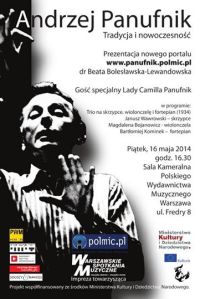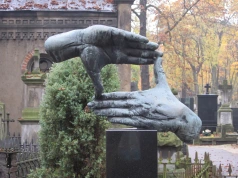
http://www.serocki.polmic.pl
The uploading of a website devoted to the life and music of Kazimierz Serocki is hugely to be welcomed. Serocki was one of the giants of post-war Polish music – he stood alongside Bacewicz, Baird, Górecki, Lutosławski and Penderecki. Yet his music has languished both at home and abroad since his death in 1981 at the age of 59. This new venture will surely do much to bring his name and output to a wider audience. It exists in parallel English and Polish versions.
It’s hosted by the Polish Music Information Centre in Warsaw and has been brought to fruition as a partnership between the Polish Composers’ Union (ZKP) and POLMIC, facilitated by the software company Noyamundi. The content has been created by Dr Beata Bolesławska-Lewandowska and Dr. hab. Iwona Lindstedt. The texts have been written by Dr Lindstedt, whose most recent publication is Sonorystyka w twórczości kompozytorów polskich XX wieku [Sonoristics in the Work of Twentieth-Century Polish Composers] (Warsaw: University Institute of Musicology, 2011).
The site is easy to navigate. There are six main sections: Biography, Timeline, Creative Output, Symphonic Frescoes, Gallery and Bibliography. As yet, there is no Discography nor a list of recordings made or held by Polish Radio or Polish Television. In this absence, you can find some information in one of my earlier posts, Serocki: A Severe Case of Neglect (3 March 2012).
Biography
Serocki’s biography has been broken down into four sections: Childhood and youth, In the new reality, Between Poland and the world and The composer’s personality. These are fluently written and are full of contextualised detail. There are plentiful quotations, especially in the final section’s recollections by his friends and colleagues. It turns out the Serocki was much more of a recluse, unwilling to talk about his music, than his now more famous and younger compatriot, Górecki.
Timeline
The Timeline is divided into decades: 1922-29, 1930s, 1940s, 1950s, 1960s, 1970s and 1980-81. While some of its material is also to be found in the Biography, there are new details, illustrations and quotes.
Creative Output
Your instincts may draw you first to the Chronological list of works. The full details of dates of composition, premiere and publication, however, and of the location of the manuscript if unpublished, are to be found under Works by genre. The entries under Works in detail are effectively mini programme notes, but can also be unexpectedly illuminating, such as that for Swinging Music, which draws on a lecture that Serocki gave in Basel in 1976.
The main weight of this section of the website is given over to four essays: Early works (1946-56, in three parts), Intermedium: dodecaphony and pointillism (1956-60), Mature works (1961-81, in three parts) and On Kazimierz Serocki’s film music. Those looking for analytical insight into Serocki’s music will find an entrée here.
These essays take the reader smoothly through Serocki’s career, pointing out key aspects and complementing the details held for specific pieces in Works in detail. They provide a good foundation for anyone minded, and able, to get hold of the scores and recordings for further study (outside Poland, unfortunately, it is no easy matter to gain access to such materials). In the essay on the early works, it is good to see that Serocki’s contribution to the genre of the mass song is addressed (this aspect of life in the early 1950s is often glossed over). The decision to group the mature works from 1960 into ‘Notation and sound space’, ‘Poetics of sounds’ and ‘Open form’ acknowledges the three main threads in Serocki’s creative thinking. The essay on the film music is especially welcome.
Symphonic Frescoes
This section seems incomplete at present. The first and second movements are represented by a recording of the work’s Polish premiere (at the 1964 Warsaw Autumn) with an accompanying scrolling score. It is a great idea that brings one of Serocki’s most brilliant works to life. Let’s hope not only that the rest of Symphonic Frescoes will be uploaded at a future date but also that other works will be similarly treated. This would get round the perpetual bind that is the lack of scores and recordings outside Poland.
Gallery
This has four subsections: Music, Voices, Video, Pictures. Many of the items here appear in the earlier sections of the website.
• Music: here you can listen to fragments of over 30 compositions from across Serocki’s career. These soundbites last between one and six minutes, so you can get a good idea of not only each work but also each movement. At some point it would be wonderful if complete pieces and movements were available.
• Voices: at present, there are five friends and colleagues of Serocki whose spoken reminiscences of the composer (in Polish) have been gathered together from the archives. The speakers are the composer Augustyn Bloch (seven extracts), the singer and author Hanna Wąsalanka, aka Sister Blanka (six), the Hungarian pianist and composer Szábolcs Esztényi (six), the composer Włodzimierz Kotoński (five) and the clarinettist Czesław Pałkowski, best known perhaps for being a member of the Music Workshop ensemble (four). These reminiscences cover a wide range of topics, from Serocki’s famous sense of humour to recollections of Darmstadt. There are no transcriptions or translations here, but transcriptions of excerpts from this archival sound material do appear earlier in the site, especially in Creative Output.
• Video: these are mostly short excerpts from performances at ‘Warsaw Autumn’ festivals of Episodes (1958-59), Niobe (1966), Poezje (1968-69), Fantasia elegiaca (1971-72, Ad Libitum (1973-77) and Pianophonie(1976-78). There is also a complete performance of Continuum (1965-66), a voice-over introduction to an excerpt from Swinging Music (1970) played by Zygmunt Krauze’s Music Workshop, and a short animated filmWspaniały marsz (Splendid March, 1970) for which Serocki wrote the music.
If you want to hear complete performances of works by Serocki, several are currently on YouTube (some added quite recently), including the pieces for trombone from the early 1950s, Sinfonietta (1956), Episodes, Segmenti (1961), A piacere (1963), Symphonic Frescoes (1964), Continuum, Swinging Music, Fantasmagoria (1971) and Pianophonie.
A video of Fantasmagoria has recently been uploaded at http://www.youtube.com/watch?v=JUzWEotLN0Q, as has one of Fantasia elegiaca at http://www.youtube.com/watch?v=g4NuCcpakbU.
• Pictures: these are grouped in six categories – Documents and correspondence (58), Photos (34), Printed scores (110), Music manuscripts (27), Texts (32) and Press clippings (32). Although none of the texted items is translated here (some appear elsewhere on the site), the caption beneath each image is usefully in English. These are fascinating documents to explore, giving new insights into all periods of his public and personal life.
Bibliography
The Bibliography is almost exclusively of Polish sources, including items by the main authors on Serocki’s music, such as Tadeusz Zieliński and Tomasz Kienik, who have each published several articles. Zieliński’s study O twórczości Kazimierza Serockiego [On Kazimierz Serocki’s Oeuvre] (Kraków: PWM, 1985) remains the only monograph on Serocki’s music. There is also a short list of primary sources (lecture typescripts, manuscript notes) held in the Warsaw University Library (BUW).


